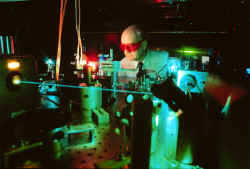Spinning the Molecule

Lasers can now routinely be used to nudge, trap, and stir atoms to perform Nobel-prizewinning feats, but so far molecules have avoided being subject to the same level of control. Now a paper in the 26 April PRL is the latest suggesting this might soon change. The paper describes how to use short laser pulses to create large rotational forces on molecules, causing them to rapidly spin around at speeds that can be extremely well controlled. These “optical centrifuges” can then be used to perform all sorts of molecular gymnastics, from tearing apart bonds that normally would not break, to separating heavier molecules from light ones.
Atoms are amenable to manipulation by light because they are simpler than molecules. It is possible to isolate just two atomic energy levels and tune lasers to the energy difference between those levels, which corresponds to a particular, or resonant, frequency. Being a resonant frequency of the atom, even a weak laser pulse then produces forces strong enough to control the atom, much like pushing gently on a swing at the same frequency it naturally moves will amplify the amplitude. But even the simplest molecules have a complicated pattern of energy levels that are usually very close together, so photons from even a finely tuned laser will usually end up being absorbed by levels that are not supposed to absorb them. In the past few years, however, researchers have started learning how to use nonresonant laser pulses to produce forces sufficient for controlling molecules. Joanna Karczmarek and Misha Ivanov, physicists at the Steacie Institute for Molecular Sciences in Ottawa, Canada, and their colleagues, have found a way to fashion a nonresonant infrared laser pulse to rotate molecules.
The researchers imagined the molecule being hit by laser pulses that initially lasted just a few trillionths of a millisecond, but were then stretched out to last a thousand times longer. These pulses would moreover be polarized–the electric field associated with them would vibrate in just one direction. A molecule placed in a polarized infrared field, the researchers reasoned, will align itself along the direction of polarization. If the polarization of the field were made to slowly rotate, the molecule would follow. Finally, if the rotation of the polarization is accelerated, the molecule would experience centrifugal forces that could either distort or even break some of its bonds. In their paper, the team describes exactly how to bring about this acceleration, which involves combining two rotating polarized beams, one that is rotating clockwise and the other counterclockwise. If the beams are of different frequency and their frequency difference is changed, the rotation of polarization will accelerate. The researchers show that in theory, their optical centrifuge can be used to separate dichlorine molecules made up of different numbers of neutrons (isotopes)–the molecules made from heavier isotopes fly apart before the lighter ones because of a tiny difference in their moments of inertia, measures of how they respond to rotation.
Both Ivanov’s group and other researchers are working on applying the ideas of the theory in the laboratory to create a real optical centrifuge. Donna Strickland of the University of Waterloo in Ontario wants to use the technique to selectively break the stronger bonds of molecules. “If you can break specific bonds that [you] normally couldn’t, you can pick and choose what atoms you want on your molecule,” she says. That, she adds, would give researchers ultimate control in designing different molecules.
–Meher Antia
Meher Antia is a freelance science writer.


